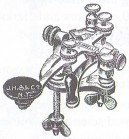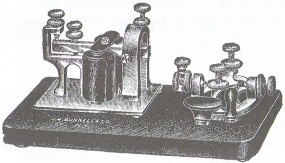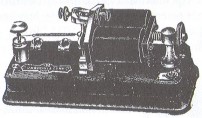"Our present system of insulation is a positive disgrace to the
scientific ability of our American telegraphic engineers." G. Prescott,
1866
During my years of collecting Hemingray insulators, I often wondered about
the conversations that had gone over the wires carried by these glass jewels.
Today we think of telephone conversations as the major impetus for the
construction of pole lines with wires and insulators, but what really got it
started was the telegraph. Interestingly enough, the first telegraph line was
buried, not aerial. In 1843 Samuel Morse began construction of an experimental
line along the rail line between Baltimore and Washington using wires in buried
lead pipes. The copper wires, however, were not properly insulated and the
entire route had to be rebuilt above ground on wooden poles. In 1844 the line
was completed and Morse sent the first telegraph message, "What hath God
wrought?", from the Supreme Court Chamber in Washington, D.C. to Baltimore
over the 40-mile wooden pole line route. The age of telecommunications was born
and along with it the urgent need for insulators and telegraph equipment. By
1850, 22,000 miles of telegraph lines had been strung to points as distant as
Washington, D.C., New Orleans, Iowa, Maine and Canada. By 1866, there were more
than 50,000 miles of mostly iron lines in operation having more than 1,400
telegraph stations and employing upwards of 10,000 operators and clerks. That
same year an estimated five million messages traveled over these facilities,
producing an annual revenue of $2.2 million. Of interest to insulator collectors
is that in 1866 an estimated 1.5 million insulators were already in service.
|

COVER: Complimenting Jerry Post's article on telegraph
equipment (page 3 0 f this issue) are examples of a key, relay and sounder
that are in Jerry's personal collection. Jerry lives in Colleyville,
Texas.
|
The bane of this expanding telegraph system, however, was the insulator
supporting the wires. George Prescott, a noted scientist, wrote in 1866,
"Our present system of insulation is a positive disgrace to the scientific
ability of our American telegraphic engineers." The chief complaints being
that the insulators, especially when wet, allowed the electrical current to
escape to the supporting wooden post, and that the insulators were easily
broken. Early telegraph insulators consisted of glass plates, bureau knobs and
simple glass blocks with notches to hold the wire in place. In 1851 a patent was
issued to Nelson Goodyear for an insulator made of rubber. Insulators of wood and pottery were also developed to
overcome the objections cited by Prescott. By the mid-1860s, the majority of
insulators were glass shaped much as an insulator collector knows them today,
sans threads and drip points. For many years it was up to the developing
technology of the telegraph apparatus to work around the shortcomings of the
insulators.
First, let's talk about the telegraph apparatus that makes up the
telegraph network. Then we'll discuss the items from the perspective of the
telegraph collector. Telegraph equipment can be grouped into four broad
categories: 1) keys, 2) sounders, 3) relays, and 4) auxiliary items.
The
telegraph key (Figures 1 and 2) is the basic telegraph transmitter, a switch
with contacts that make (close) or break (open) the telegraph circuit to the
distant receiver. The key's electrical contacts are held open by a spring. When
the operator presses on the key's knob, the contacts are closed and the circuit
is completed sending the familiar dots and dashes of the Morse Code. From a
historical perspective, keys can be grouped into pre-Triumph (1844-1881), and
post-Triumph, (1881 to present.) The Triumph Key (see Figure 1) was patented
in 1881 by Jesse Bunnell who had been a telegrapher during the Civil War.
Bunnell named it Triumph because he thought his new stamped steel lever would
triumph over the design problems of existing keys that
used a heavy brass lever with steel pivots pins which eventually worked loose.

Fig. 1. The Triumph Key.
Keys were designed as either legless (Figure 1) to be attached to a table, or
leg keys (Figure 2) with bolts to be permanently attached to the table with the
wires connected underneath. Sometimes the key and sounder (see below) were
mounted on the same base as seen in Figure 3. Referred to as KOB (key on base),
these combination sets were often used for training. There were, of course,
numerous other designs and manufacturers of keys.

Fig. 2. Telegraph key
with bolts
for attachment to a
table.
The telegraph sounder (Figure
4) is the receiving instrument that transforms the electrical pulses from the distant office into a click
when its electromagnetic coils are energized and a clack when the magnets
are released. Each electric pulse from the distant key thus produces an audible
click-clack sound which is interpreted by the receiving telegraph operator as a
dot or dash. Sounders can be identified by their two vertical electromagnets.
Sounders may be either mainline or local. The mainline sounder was connected directly to the telegraph wire from
the next office. Local sounders were powered by a local battery within the
telegraph office in conjunction with a relay to detect the pulses from the
distant office.

Fig. 3. Key on base combination set.
Mainline and local sounders look much alike although the mainline may be
somewhat larger.
A telegraph relay (Figure 5) is a sensitive electromechanical repeater used
on long telegraph lines, generally more than twenty miles. The weak signal from
the distant office was rejuvenated by the relay and passed to the next office along the line. A relay is more sensitive than a
sounder and can be identified by its two horizontal electromagnets and
horizontal tension spring.

Fig. 4. The Telegraph Sounder.
Auxiliary equipment includes batteries, switchboards,
test sets, resonators, etc. There are literally hundreds of these items for the
serious collector.

Fig. 5. The Telegraph Relay.
As with insulators, the price for a telegraph item varies
based on age, condition and how rare or unique the item is. Unfortunately,
there is nothing for the telegraph collector that even begins to approach the
insulator Consolidated Design (CD) identification system, or McDougald's Price
Guide for Insulators. Tom Perera in his book, Telegraph Collector's
Guide,
states that "most buyers and sellers simply do not know what telegraph
items are worth." Despite their historical and scientific significance,
telegraph items are among the few remaining undiscovered collectibles. Ebay and
similar auctions, of course, may soon change all of this. Prices for common
keys, sounders and relays currently range from $25 to $150. Recently a particularly rare
telegraph key sold for $1,200. Prices for auxiliary telegraph apparatus are even
more variable since few people know what it is or how rare it may be.
Again, as
with insulator collectors, there is much discussion among telegraph collectors
concerning how much, if any, restoration should be done. Most collectors prefer
to keep the item in its original condition doing only what is necessary to stop
any further deterioration. But, with all that brass, a rosewood base and black
iron platform with a gold pinstripe, it is hard to resist the temptation to
restore the equipment. And, yes, it really would look great on your desk next to
a favorite insulator. The telegraph collector should be aware that a complete
restoration takes lots of work, may obliterate historical markings and should be
avoided.
Although not as numerous as the millions of insulators produced since
the 1840's, thousands of telegraph keys, sounders and relays were manufactured
to serve telegraph and railroad offices in virtually every town in the developed
world. Today, many of these items can be found at swap meets and on the Internet
auctions. They make an appropriate adjunct to our insulator collections, and we
owe a tip of the hat to the telegraph network and equipment that got it all
started more than 160 years ago. For more information on the history of
telegraphy and collecting telegraph apparatus, refer to:
The W1TP Telegraph
Museum at: http://w1tp.com
or
The Telegraph Office at:
http://fohnix.metronet.com/~nmcewen/ref.html


































































